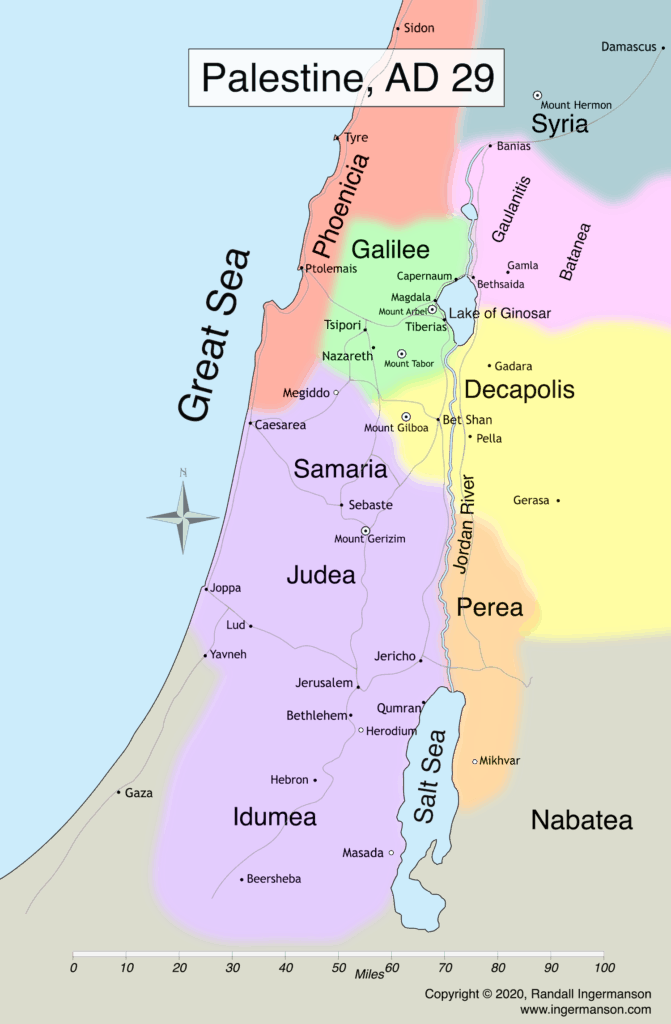There is no doubt that Jesus and his family celebrated the Jewish New Year. They were Jewish, and they naturally celebated all the standard Jewish holidays. And they probably celebrated in Jerusalem. That was a major time commitment, as we’ll see shortly.
Several important holy days come in the fall, in the month of Tishrei:
- Rosh HaShanah (the New Year) on 1 Tishrei
- Yom Kippur (the Day of Atonement) on 10 Tishrei
- Sukkot (the Feast of Tabernacles) from 15 to 21 Tishrei
So the time spanned by these holy days is three whole weeks!
Why the New Year Starts in the Seventh Month
There’s something odd going on with the Jewish New Year. If you’ve read Exodus, you know that the holiday Pesach (Passover) begins on the evening of the fourteenth day of the first month.
That first month is called Nisan in Hebrew and it normally begins in March or April.
So how is it that the Jewish New Year comes in the fall, on the first day of Tishrei, which is the seventh month of the year? How does that make sense?
That makes sense because ancient Israel used two different lunar calendars. One began on the first day of Nisan, in the spring. The second began six lunar months later, on the first day of Tishrei, in the fall.
So both Nisan and Tishrei are actually the “first month,”—just in different calendars.
The holiday that became known as the Jewish New Year used the calendar that begins in the fall with Tishrei as its first month.
A Long Walk To Jerusalem
The fall holidays were considered the very best time of the year. And ideally, you wanted to celebrate them in Jerusalem.
That was not so easy if you lived in Galilee. Nazareth, the hometown of Jesus, was about 64 miles north of Jerusalem—as the crow flies.
But it was a bit farther as the Galilean family walks.
The shortest route ran south from Nazareth through Samaria to Jerusalem. This is the route that I call “the Samaritan Road” in my novels, because it passed through Samaria. As you can see in the map below, the Samaritan Road was not quite a straight shot. There were some forks and wiggles in the road (to go around mountains and generally find the easiest route over rugged terrain.)
The distance was probably more like 75 miles of actual walking. If you were young and healthy, you could theoretically cover that in 3 days, but 4 days was much more doable. If anyone in your party was older and slower, then 5 days was probably best. 
The Samaritan Road Was Not Safe
The problem was that the Samaritan Road was not terribly safe. There was bad blood between Jews and Samaritans, going back several centuries.
The first-century historian Josephus tells us that Jewish travelers were sometimes killed on the Samaritan Road on their way to the annual holidays. On at least one of these occasions, Jews then went north from Jerusalem and wreaked their vengeance on the Samaritans.
But we know that Jews often took the Samaritan Road to Jerusalem. They probably had two reasons:
- The Samaritan Road was the shortest route from most parts of Galilee.
- The Samaritan Road went through the hill country, which was cooler than the other routes.
The gospels tell of at least two occasions when Jesus took the Samaritan Road (John 4:4-6 and Luke 9:51-55).
The Jordan Way Was a Little Safer
But Galileans had another route they could take to Jerusalem. They could head east and south until they reached the Jordan River south of the Sea of Galilee. Then they could walk south along the Jordan River (on either the east or west side) until they reached Jericho. Then it was a steep one-day climb from Jericho to Jerusalem, going west on the Jericho Road.
I call this entire route “the Jorday Way” in my novels, because a big part of the trip was alongside the Jordan River.
This was certainly a safer route for most of the trip, except for the last day climbing on the Jericho Road, which was notorious for bandits. (The story of the Good Samaritan is set on the Jericho Road).
But there were three main problems with the Jordan Way:
- For most Galileans, the Jordan Way was a longer route.
- The Jordan Way ran along the Jordan Valley, several hundred feet below sea level, which made it hotter.
- The last day of the route on the Jordan Way led up the steep Jericho Road, which made for a long, hard day of travel through lonely, dangerous country.
We know that Jesus took the Jordan Way at least once, on his final trip to Jerusalem.
A Backpacking Expedition
Whichever route you took to Jerusalem, you were looking at a trip of several days.
Getting to Jerusalem was essentially a backpacking expedition with very stripped-down equipment. You could take a pack animal, in theory, but most travelers probably just carried or wore everything they needed.
And what would you need? Here is a list of the things I’d consider essential for the trip:
- A tunic, made of wool, which covered down to your knees (if you were a man) or down to your mid-calf (if you were a woman). You did not wear underwear or socks. You did not need an extra tunic.
- For women only—a hair covering that completely obscured your hair.
- A cloth belt that wrapped around your waist and could hold coins, a knife, and other small personal items.
- Leather sandals.
- A warm woolen cloak to protect against cold and rain. This also worked nicely as a sleeping bag.
- A leather pack you could wear on your back to hold your cloak and a day’s worth of food.
- A waterskin to carry one day’s worth of water or beer. (In a world where you take water out of a well or a river, beer was often safer to drink, and it could purify water taken from a sketchy source.) The waterskin hung on a leather cord that you could sling over your neck and shoulder.
- A few silver coins to buy food and drink along the way, and to pay for a place to stay in Jerusalem, and for any sacrifices you intended to make at the Temple. Two or three coins per person per week should be enough.
- Optional (but strongly recommended)—a short knife. For general use, and for very modest protection from bandits.
And that’s all! You could wear all of it, leaving your hands free. It was light enough for each person to carry their own load.
Along the way to Jerusalem, I would expect that most people just camped out under the stars at night. There just weren’t enough inns to house thousands of travelers during the busy season.
I would also expect that they simply bought food along the way and either replenished their waterskins at every well or bought beer when they bought food.
In Jerusalem, you would need to rent a house or a room to stay. This would probably be small and barely furnished, but it would be hardly different than your home back in Galilee.
Jesus made this trip every year for the major holidays. And like any good and loyal Jew, he loved every minute of it.
